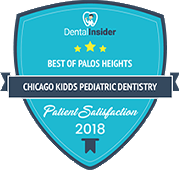How to Prevent Baby Bottle Rot & Tooth Decay
Posted on January 18th, 2023 | Christopher Neal

Young children are sometimes at risk for a condition called baby bottle tooth decay, also known as bottle rot. This happens when a child frequently drinks sugary liquids, like juice, sweetened milk, or formula, especially from a bottle over long periods. The sugars in these drinks can cling to your child’s teeth, feeding bacteria that cause decay.
While it’s much easier to prevent baby bottle tooth decay than to treat it, early dental care can still make a big difference if decay starts to appear. At Chicago kiDDS Pediatric Dentistry, our team is experienced in spotting and treating early childhood cavities with care and expertise.
What is Baby Bottle Rot?
According to the American Academy of Pediatrics, baby bottle tooth decay is a condition that usually affects a child’s upper front teeth. While drinking from a bottle is a normal part of early childhood, problems can arise when bottles are used too often, especially at bedtime or naptime. If a child falls asleep with a bottle or sips on sugary drinks throughout the day, their teeth can stay coated in sugar, increasing the chance of decay.
How Common is Bottle Rot?
According to a survey completed by the CDC, approximately 23% of children aged 2-5 develop dental cavities in their primary teeth. This means that as many as 1 in 5 children may develop bottle rot in their early years.
Signs of Bottle Rot
Some signs of baby bottle tooth decay include the following:
- White spots on teeth
- Toothaches
- Cavities (also called dental caries)
- Bleeding or inflamed gums
- Fever if infection has occurred
- Tooth erosion
If you notice any of these signs, it’s important to see a pediatric dentist as soon as possible to prevent the problem from getting worse.
What Does Bottle Rot Look Like?
Bottle rot can look like small white or brown spots on your child’s teeth. It can also look like tooth erosion or inflamed gums. However, keep in mind that in many cases, there are no visible signs of bottle rot. It’s important to bring your child to a dentist if you have any concerns about their dental health.
What Causes Baby Bottle Tooth Decay?
Baby bottle rot, or bottle mouth, is caused by the excessive consumption of sugary drinks from a baby bottle. Many children like to go to bed with a bottle or carry it around as a security blanket. However, due to the shape of bottle openings, this can cause the beverage of choice to gather around their teeth and gums.
Baby bottle tooth decay is also called “milk rot” because sweet drinks like milk, formula, and juice are responsible for causing tooth decay, especially of the front teeth.
Bottle Rot Treatment
How to Prevent Bottle Rot
Baby teeth may be temporary, but they play a big role in your child’s health and development. Thankfully, a few simple habits can help protect your child’s smile from bottle rot:
1. Wipe After Every Feeding
Use a clean, damp gauze pad or soft washcloth to gently wipe your baby’s gums after feeding. This helps clear away milk residue and prevents harmful bacteria from building up.
2. Start Brushing Early
As soon as teeth begin to emerge, brush them gently using a child-sized toothbrush. Use a tiny smear of fluoride toothpaste—about the size of a grain of rice.
3. Use the Right Amount of Toothpaste
Increase the amount of fluoride toothpaste to a pea-sized dab once your child reaches three years of age. Help your child brush their teeth twice a day and remind them to spit out the toothpaste instead of swallowing it.
4. Supervise Brushing
Children usually need help brushing until they’re at least 6 or 7 years old. Make brushing a shared activity so you can monitor their technique and make sure they’re doing it properly.
5. Avoid Sugary Drinks
Stick to breast milk, formula, or plain milk. Avoid sugary drinks like juice, soda, or sweetened water, which can stick to the teeth and lead to decay.
6. Skip Bedtime Bottles
If your baby falls asleep with a bottle in their mouth, the liquid can pool around the teeth and feed bacteria overnight. Finish all bottles before putting your baby down for sleep.
7. Keep Pacifiers Clean
Never dip pacifiers in honey, sugar, or syrup. And avoid cleaning pacifiers in your own mouth—this can pass bacteria to your baby that contributes to tooth decay.
8. Move to a Cup by Age One
By your child’s first birthday, start offering drinks in a training cup or open cup instead of a bottle. This helps reduce the risk of prolonged exposure to liquids that can cause cavities.
9. Choose Nutritious Foods
Offer healthy snacks like fruits, veggies, cheese, or plain yogurt instead of sugary treats. A well-balanced diet supports your child’s overall health.
10. Keep Your Child Hydrated
If your child is old enough to drink water, encourage them to take sips throughout the day, especially between meals. Water helps wash away food particles and keeps the mouth clean.
Treating Bottle Rot
If your child already shows signs of tooth decay, such as brown or white spots on their teeth, pain while eating, or sensitivity to hot and cold foods, it’s important to take action. Bottle rot, or early childhood caries, can worsen quickly without treatment. The good news is that with professional care and a consistent routine, your child’s smile can recover.
Step 1: See a Pediatric Dentist
As soon as you notice signs of decay, schedule an appointment with a pediatric dentist. Dentists who specialize in children’s dental care know how to treat young patients gently and effectively. Early treatment can stop the decay from spreading and save your child’s teeth from more serious damage.
At the visit, your child’s dentist will examine the teeth and may take X-rays to check the extent of the decay. Depending on how advanced it is, the treatment plan may include fluoride treatments, fillings, crowns, or other options.
Step 2: Follow the Treatment Plan
If the decay is still in its early stages, a fluoride varnish or gel can help strengthen the enamel and reverse damage.
More serious cavities may require fillings. In cases of severe decay, the dentist might recommend crowns to protect the teeth and preserve function. For young children or those with dental anxiety, your pediatric dentist may offer sedation options to make the treatment process smoother and more comfortable.
Step 3: Practice Daily Home Care
Keep Brushing and Flossing
Continue brushing your child’s teeth twice daily using fluoride toothpaste. If your child has trouble reaching all areas, assist them with brushing and consider using flossers for tight spaces.
Monitor Eating Habits
Avoid giving sugary snacks and drinks between meals. Encourage healthy options like fresh fruits, vegetables, and water to reduce the risk of further decay.
Limit Bottles and Sugary Liquids
Only give bottles with milk, formula, or water—never juice or soda. Try to avoid letting your child fall asleep with a bottle in their mouth.
Step 4: Follow-up Care
After treatment, regular dental checkups are essential. Your dentist will monitor the treated areas and help make sure your child’s teeth are developing properly.
Talk to your pediatric dentist about sealants, fluoride supplements, or other preventive tools that can help keep your child’s smile healthy.
Speak to a Pediatric Dental Expert
The earlier baby bottle tooth decay is treated, the better the outcome for your child. Ignoring it can lead to pain, infection, and problems with permanent teeth later on. At Chicago kiDDS Pediatric Dentistry, we specialize in treating children with kindness, patience, and expert care.
Call (708) 448-6700 today to schedule an exam with our team. Whether your child needs a small filling or more advanced care, we’re here to help restore their smile and their confidence.












